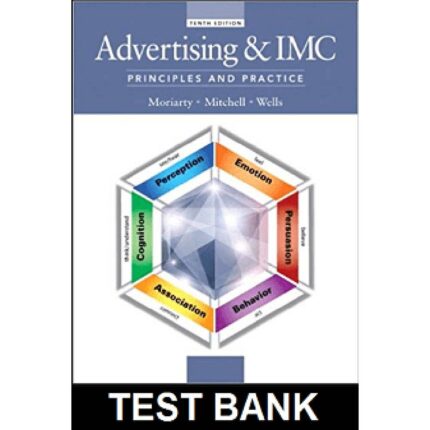Marketing 4th Canadian Edition By Grewal – Test Bank
Chapter 11
Pricing Concepts and Strategies: Establishing Value
Multiple Choice Questions
- Which of the following is NOT true about pricing?
A.It is the only element of the marketing mix that generates revenue
B. Implementing a good pricing strategy is challenging but can be effective for a very long time
C. Price is broader than the money customers pay to purchase a product.
D. Price is one of the most important factors in customer purchase decisions
E. Pricing decisions should be viewed as opportunity to create value for customers.
Even if a pricing strategy is implemented well, consumers, economic conditions, markets, competitors, government regulations, and even a firm’s own products change constantly and that means a good pricing strategy today may not remain an effective strategy tomorrow.
Accessibility: Keyboard Navigation
Blooms: Understand
Difficulty: Moderate
Learning Objective: 11-01 Explain what price is and its importance in establishing value in marketing.
Topic: 11-01 The Importance of Pricing
- The following are critical components of pricing strategies EXCEPT:
A.Promotions
B. Objectives
C. Competitions
D. Costs
E. Customers
The five critical components of successful pricing strategies are: company objectives, competition, costs, customers, channel members.
Accessibility: Keyboard Navigation
Blooms: Remember
Difficulty: Moderate
Learning Objective: 11-02 Illustrate how the five Cs—company objectives; customers; costs; competition; and channel members—influence pricing decisions.
Topic: 11-02 The Five Cs of Pricing
- A firm with a company objective that can be implemented by focusing on target return pricing is using a:
A.sales orientation.
B. customer orientation.
C. profit orientation.
D. demand orientation.
E. competitor orientation.
Even though all company objectives may ultimately be oriented toward making a profit, firms implement a profit orientation as a part of their company objective by focusing on target profit pricing, maximizing profits, or target return pricing.
Accessibility: Keyboard Navigation
Blooms: Remember
Difficulty: Easy
Learning Objective: 11-02 Illustrate how the five Cs—company objectives; customers; costs; competition; and channel members—influence pricing decisions.
Topic: 11-03 Company Objectives
- The usual pricing strategy implemented by firms when they have a particular gain goal as their overriding concern is the:
A.market penetration strategy.
B. target return pricing strategy.
C. improvement value strategy.
D. competitive parity strategy.
E. target profit pricing strategy.
Firms usually implement target profit pricing when they have a particular profit goal as their overriding concern. To meet this targeted profit objective, firms use price to stimulate a certain level of sales at a certain profit per unit.
Accessibility: Keyboard Navigation
Blooms: Remember
Difficulty: Easy
Learning Objective: 11-02 Illustrate how the five Cs—company objectives; customers; costs; competition; and channel members—influence pricing decisions.
Topic: 11-03 Company Objectives
- What is implemented by firms that focus on the rate at which their profits are generated relative to their investments rather than the absolute level of profits?
A.Maximizing profits strategy
B. Target return pricing strategy
C. Value-based strategy
D. Competitive parity strategy
E. Target profit pricing strategy
Target return pricing is a pricing strategy implemented by firms less concerned with the absolute level of profits and more interested in the rate at which their profits are generated relative to their investments. It is designed to produce a specific return on investment, usually expressed as a percentage of sales.
Accessibility: Keyboard Navigation
Blooms: Remember
Difficulty: Easy
Learning Objective: 11-02 Illustrate how the five Cs—company objectives; customers; costs; competition; and channel members—influence pricing decisions.
Topic: 11-03 Company Objectives
- The maximizing profits strategy primarily relies on:
A.advertising theory.
B. management theory.
C. marketing theory.
D. relativity theory.
E. economic theory.
The maximizing profits strategy relies primarily on economic theory. If a firm can accurately specify a mathematical model that captures all the factors required to explain and predict sales and profits, it should be able to identify the price at which its profits are maximized.
Accessibility: Keyboard Navigation
Blooms: Remember
Difficulty: Easy
Learning Objective: 11-02 Illustrate how the five Cs—company objectives; customers; costs; competition; and channel members—influence pricing decisions.
Topic: 11-03 Company Objectives
- Slate Inc. is the parent company of five brands. Slate decides that all the products under every brand must make a 20 percent gain margin in the upcoming financial year. This is an example of:
A.profit orientation.
B. customer orientation.
C. sales orientation.
D. cost orientation.
E. competitor orientation.
This is an example of profit orientation. Profit orientation is a company objective that can be implemented by focusing on target profit pricing, maximizing profits, or target return pricing.
Accessibility: Keyboard Navigation
Blooms: Apply
Difficulty: Difficult
Learning Objective: 11-02 Illustrate how the five Cs—company objectives; customers; costs; competition; and channel members—influence pricing decisions.
Topic: 11-03 Company Objectives
- When determining its pricing strategy, if a firm is willing to let profits suffer in order to increase its customer base, the company objective is most likely to be:
A.sales oriented.
B. customer oriented.
C. profit oriented.
D. cost oriented.
E. quality oriented.
Firms using a sales orientation to set prices believe that increasing sales will help the firm more than increasing profits. Such firm could choose to set prices very low to generate a large volume of sales, even if that would cause profits to suffer initially.
Accessibility: Keyboard Navigation
Blooms: Understand
Difficulty: Moderate
Learning Objective: 11-02 Illustrate how the five Cs—company objectives; customers; costs; competition; and channel members—influence pricing decisions.
Topic: 11-03 Company Objectives
- Blue Corp., a company that manufactures high quality mobile phones, is set to launch a new series of tablets. In order to reduce competition and increase the demand for the new products, the company launches them at a very low price. Blue’s objective is most likely to be:
A.sales orientation.
B. customer orientation.
C. profit orientation.
D. quality orientation.
E. competitor orientation.
Blue’s objective is most likely to be sales oriented. Firms using a sales orientation to set prices believe that increasing sales will help the firm more than increasing profits. Setting prices very low to generate new sales and take sales away from competitors, even if profits suffer, is an example of sales-oriented objectives.
Accessibility: Keyboard Navigation
Blooms: Apply
Difficulty: Difficult
Learning Objective: 11-02 Illustrate how the five Cs—company objectives; customers; costs; competition; and channel members—influence pricing decisions.
Topic: 11-03 Company Objectives
- A company launches a new car in the luxury segment. It studies the quality and price of other luxury cars available in the market and ensures that the price and features of the new launch are similar to the existing cars. The company’s objectives are most likely to be:
A.sales oriented
B. customer oriented.
C. profit oriented.
D. cost oriented.
E. competitor oriented.
In this case, the company’s objective is likely to be competitor oriented. When firms undertake a competitor orientation, they strategize according to the premise that they should measure themselves primarily against their competition. Some firms focus on competitive parity, which means they set prices that are similar to those of their major competitors.
Accessibility: Keyboard Navigation
Blooms: Apply
Difficulty: Difficult
Learning Objective: 11-02 Illustrate how the five Cs—company objectives; customers; costs; competition; and channel members—influence pricing decisions.
Topic: 11-03 Company Objectives













Reviews
There are no reviews yet.